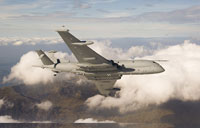|

|
|

|
The Nimrod MR Mark
2P, has been developed for long-range maritime patrol. The Nimrod MR2
carries out three main roles; Anti-Submarine Warfare (ASW),
Anti-Surface Unit Warfare (ASUW) and Search and Rescue (SAR).
Its long ferry range enables the crew to monitor maritime areas far to
the north of Iceland and up to 4,000 km out into the Western Atlantic.
With AAR (Air-to-Air Refuelling), its range and endurance is greatly
extended.
The MR2 is a very lethal submarine killer carrying the most up to date
sensors and data processing equipment linked to the weapon systems. In
addition to weapons and sonar-buoys, a searchlight mounted in the
starboard wing pod can be used for search and rescue (SAR)
operations.
Nimrod is a
development of the basic Comet No 4C airframe that dates from the late
1940s. Both the current variants are descended from the original
Nimrod MR Mark 1 version (first flight May 1967) upgraded during the
1980s.
Crew members comprise 2 x Pilots and a flight engineer operate the
flight deck, 2 x Navigators, an Air Electronics Officer (AEO), the
sonobuoy sensor team of 3 x Air Electronic Operators and 4 x Air
Electronic Operators to manage a wide range of avionics and weapon
systems.
The second version is the R Mark 1, an aircraft specially fitted out
for the gathering of electronic intelligence and only three are known
to be in service. This is a highly secret aircraft that has been in
RAF service since 1971 and about which little is known except that has
been spotted on patrol over the Baltic Sea. The Nimrod R1s are
externally distinguishable from the maritime reconnaissance version by
the absence of the magnetic anomaly detection tail booms and a
distinctive pod on the leading edge of the port wing. In-flight
refuelling probes were added in 1982.
Under a £2.2 billion contract in July 1996, the Nimrod upgrade
programme involved 21 Nimrod MR2 aircraft to Maritime Reconnaissance
Attack 4 (MRA4) standard, together with training and integrated
logistics support packages.
The programme would involve the total replacement of the aircraft's
systems and over 80 percent of its airframe, resulting in the RAF
receiving back practically a new aircraft. There has been a
substantial programme cost escalation (estimated programme cost £3.8bn
by 2005) and considerable slippage. Numbers of MR4 to be procured have
reduced from 21 to 12 as a result of cost escalation.
The operational impact of the slippage will be partly mitigated by
existing measures to introduce upgrades to some Nimrod MR2 systems,
notably Replacement Acoustic Processors (RAP), navigation systems,
datalinks and other communications to address inter-operability
issues.
Nimrod MRA4 will have a reach extending to some 6,000 miles, compared
to the current MR2 capability of some 3800 miles. Rolls BR710 engines
replace RR Spey engines. Other capability improvements over MR2
include increased time on station, a major improvement in overall
sensor performance and weapon carrying capability. The new digital,
integrated mission system features the Searchwater 2000 radar,
UYS503/AQS970 sonar, DASS 2000 ECM, and EL/L8300UK ESM. The crew
complement has reduced by 25%.
Weapons will include torpedoes (Tigerfish), AGM-84 Harpoon anti-ship
missiles (range 50 nautical miles) or AIM-9 Sidewinder air-to-air
missiles for defence against hostile aircraft.
|
NIMROD
MR2
Specifications
|
|
Type |
Maritime
Patrol |
|
Manufacturer |
BAe |
| Crew
|
Two pilots,
flight engineer, two navigators, air electronics officer and 7 air
electronic operators |
| Span
|
35m
|
| Height
|
31ft (9.45m) |
| Length
|
126ft 9in (38.63m) |
|
Weight |
Empty weight 102,515lb
(46,500kg), Max takeoff weight 232,315lb (105,376kg) |
| Operating
Range |
3,800miles/6,080 km |
| Endurance |
10-12
hrs |
| Max
Speed |
575mph/926kmph |
| Engines |
four
Rolls-Royce Spey turbofans, 12,140lb thrust each |
| Armament |
Sidewinder
AIM-9, Harpoon, 9 x Mark 46 or Stingray
Torpedoes, Bombs
and around 150 sonobuoys |
| Variants |
Nimrod MR2 maritime patrol, Nimrod
R1 Electronic Surveillance |
Photo Copyright BAe
Systems
|